7 Steps to Creating a Successful Kanban Roadmap
Rigid product roadmaps that feel outdated the moment you create them – that’s the reality of most product managers. Kanban roadmaps might be the solution to it.
These visual tools offer a flexible, customer-focused approach to managing development and delivering value.
In this guide, you’ll learn:
- The basics of what Kanban roadmaps are and why they’re beneficial.
- A step-by-step approach to creating your own.
- How to use Kanban principles to improve team focus and adaptability.
What is a Kanban roadmap?
A Kanban roadmap is a visual way to plan and track product development by dividing work into stages (like “To Do,” “In Progress,” and “Done”).
Kanban roadmap uses cards to represent features or initiatives. Unlike traditional roadmaps with dates, this type of roadmaps emphasizes a continuous flow of work and focus on completing tasks efficiently.
Product teams use Kanban roadmaps as a hybrid roadmap approach. It helps you capture both future plans and the short-term tasks to handle. Because the Kanban approach is highly visual, you can clearly distinguish between both task categories.
How to create a Kanban roadmap?
Here’s a step-by-step guide to creating a Kanban roadmap:
1. Choose Your Tool
Here, you have two general options to choose from:
- Physical roadmaps: A whiteboard, wall, and tons of sticky notes
- Digital Kanban Tools: An app designed for Kanban workflows
As you probably imagine, the first solution can get messy fast. It’s sometimes used by tiny teams who spend all their work time in the same room.
The digital tools allow more flexibility, no matter your team size, location, and complexity of the project. This facilitates continuous collaboration and lets your Kanban grow alongside your team.
Once you picked your Kanban roadmap tool, time to start putting labels on it:
2. Define Your Workflow Stages
The simplest division of tasks is: “To do,” “In progress,” and “Done.”
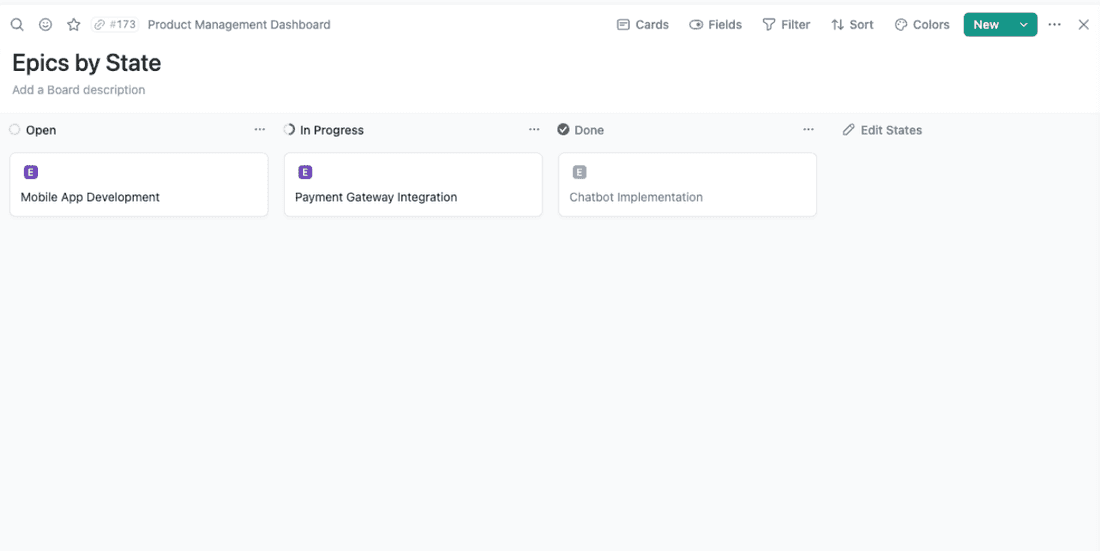
But those stages aren’t enough most of the time. For example, some tasks get stuck “In progress” when you start working on them but have to stop because of unexpected factors.
To account for instances like those, product teams usually supplement their Kanban board with more accurate stages, such as:
- Backlog
- Design
- Blocked
- Development
- Testing
- Released
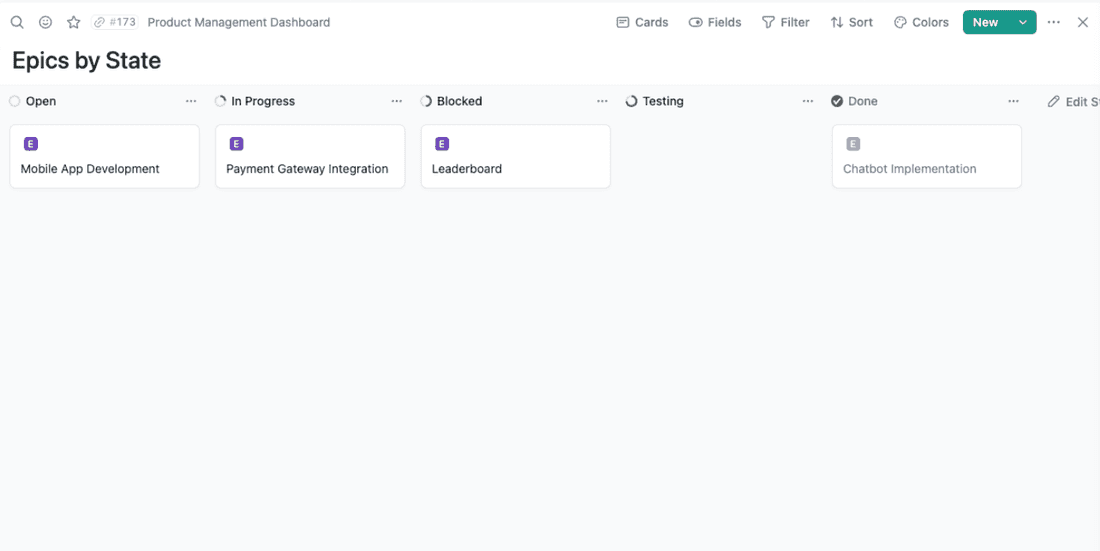
To find the best status descriptions for your team, consider:
- Granularity: How detailed do you need your stages to be? A simple “To Do > In Progress > Done” might suffice for some, while others need more steps.
- Reflect Your Process: Your workflow stages should mirror your actual development or product release process as closely as possible. Think of:
- Design/Planning: Do you have a separate stage for ideation, design, and wireframing?
- Development: Do you want to break this into smaller steps (e.g., coding, code review, testing)?
- Deployment: Do you need a “QA” or “Staging” environment before features go live?
- Bottleneck Identification: Where do items tend to get stuck? Adding a stage to highlight that bottleneck makes the problem obvious and can guide process improvement discussions.
Here is how some sample workflows might look like:
- Simple Workflow: Backlog > Design > Development > Testing > Done
- High-Level Software Development: Ideas > To Do > In Development > Code Review > QA > Released.
- Content Creation: Research > Outline > Draft > Editing > Published
Feel free to experiment and adjust the statuses to your unique needs. The goal is to find the most accurate yet concise descriptions for each stage.
The best approach is to start with fewer stages and add more as you identify a need. Too many stages can hinder flow.
Also, don’t forget your team’s input. Get feedback from your team on what workflow stages best represent their day-to-day work. They’re the ones using the board!
3. Populate with Features or Initiatives
Once you have the statuses figured out, it’s time to fill them out with tasks. But it’s not as easy as it may sound. Here’s how to do it right:
First, you need to focus on actionable items. Start with your backlog and focus on high-priority features.
Each card needs to represent a piece of work that can be moved through your workflow. Avoid overly broad or vague ideas.
For example, a task “Customer Onboarding” entails tens or hundreds of smaller sub-tasks. Such a general description doesn’t really tell the team what they should do with it. Here’s how to make it more actionable:

Each card is a manageable unit, enhancing the flow of the tasks on the board.
Another aspect of an effective Kanban Roadmap is a systemized way to name and describe your tasks. At minimum, include:
- Card Title: A clear, concise name for the feature or initiative.
- Short Description: One or two sentences outlining what the card encompasses.
Additional details you may consider including in your task cards are:
- Priority: High, medium, or low (or a more elaborate system – we describe it in the next section).
- Estimated Effort: Rough idea of the expected scope (t-shirt sizing, story points, etc.).
- Owner: Who’s responsible for the card (helpful for larger teams).
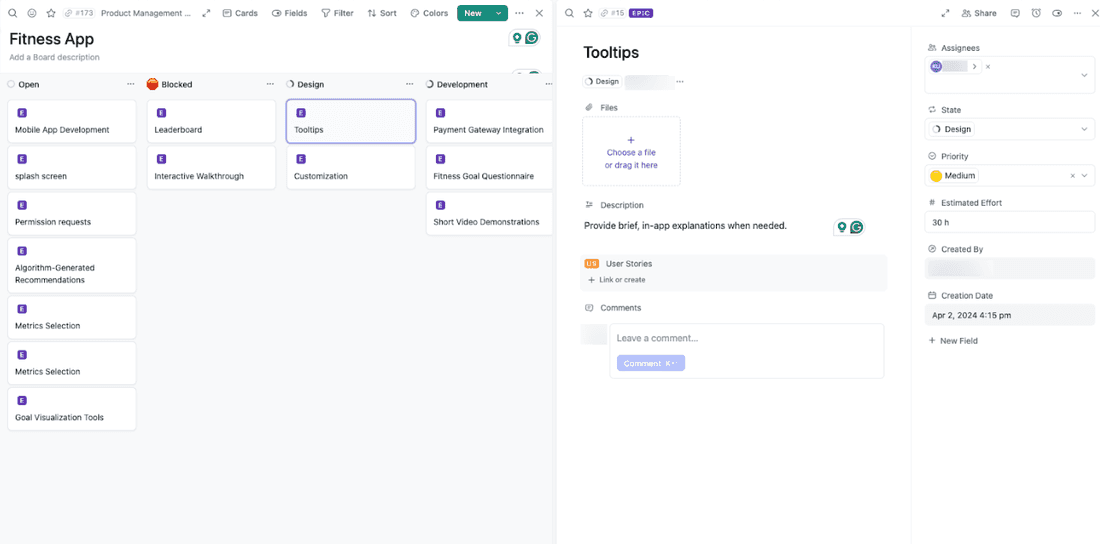
4. Prioritize and Visualize
By now, you should have a board with a bunch of tasks ready. The question is – where should you start? That’s where we’ll incorporate prioritization into your Kanban board.
For starters, pick your prioritization framework of choice. Some examples include:
- MoSCoW: Categorizes features as Must-Have, Should-Have, Could-Have, Won’t-Have. Start by pulling Must-Haves into your “To Do” column.
- Value vs. Effort: Assesses features based on their potential impact versus the effort to implement them. Helps identify quick wins (high value, low effort).
- Other Frameworks: Consider methods like RICE scoring (Reach, Impact, Confidence, Effort) or the Kano model if they better match your team’s needs.
You can assign the priority score to each card on your board:
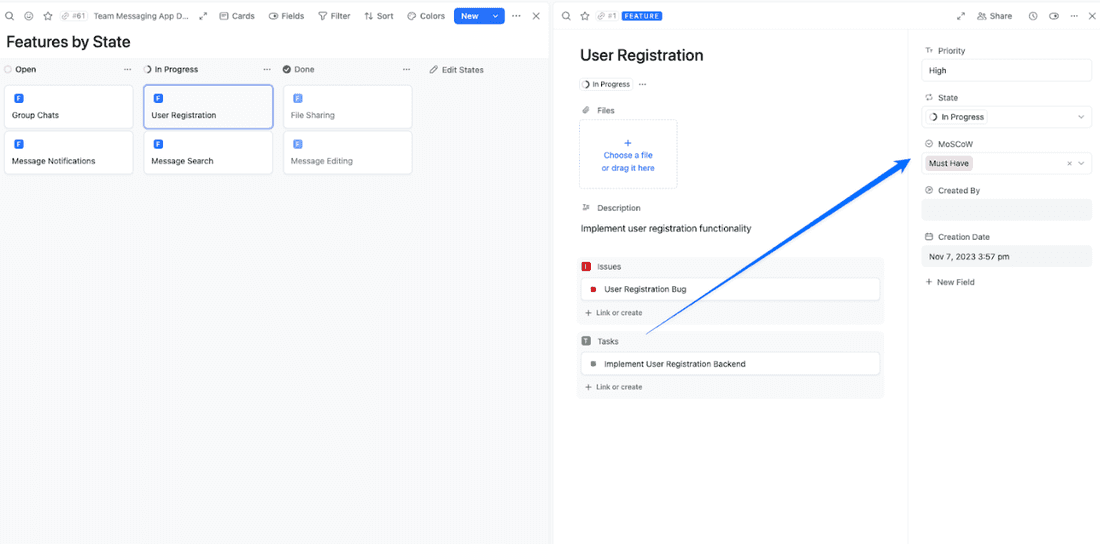
The next step is to organize the cards on your board. A couple of guidelines you can follow:
- Ordering Within Columns: Within your “To Do” (or Backlog), cards at the top generally signify higher priority.
- Swimlanes: Horizontal rows can divide work types (e.g., a “Bug Fixes” swimlane separate from “New Features”).
- Color-Coding: Color cards by priority level, project type, or team ownership.
- Labels: Use digital tool labels for additional filtering and organization.
Implementing all those should leave you with a neat Kanban board ready for your team to use. A few key points to control once the work starts:
- Clarity is the goal: Anyone glancing at the board should understand what’s most important and why.
- Review Regularly: Revisit prioritization often, especially as the market shifts or you learn from earlier stages of your roadmap.
Team Collaboration: Prioritization decisions should involve discussion among product, development, and stakeholders.
5. Start the Flow
Time to put that Kanban roadmap into good use. Here are a few guidelines to ensure it’s helping you consistently:
The core principle of Kanban is that team members pull tasks as they have capacity rather than having work pushed to them. This reduces overloading individual team members and helps highlight potential bottlenecks.
Managing the Work-In-Progress (WIP) limits helps here. They define the maximum number of cards allowed in a given stage at one time. This does the following:
- Encourages completing items before starting new ones.
- Makes it harder for work to pile up.
- Exposes bottlenecks quickly (if a stage is always at its WIP limit, there’s a problem upstream).
The overall goal is to move cards through the workflow efficiently, reaching the “Done” stage as smoothly as possible. Celebrate these completions and then pull the next highest-priority item into the workflow.
If a card is stuck for an unusual amount of time, make it visible. You can move it to a “Blocked” stage or apply a different color to the card.
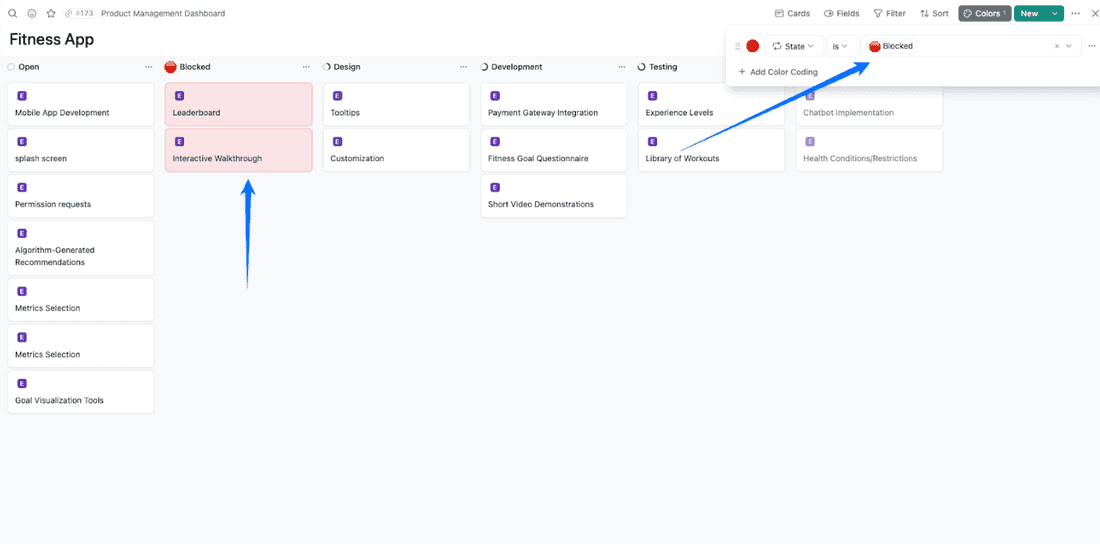
Blockages prompt a discussion of how to resolve the issue and improve the flow of work.
6. Measure and Analyze
Kanban’s focus on continuous improvement relies heavily on data. Here are the key metrics to track and what they tell you:
-
Cycle Time: The average time it takes for a card to move from “To Do” to “Done.”
- Goal: Identify where tasks spend the most time, revealing process bottlenecks.
- Long cycle times may indicate blocked items, overly large tasks, or stages that need a redesign.
-
Throughput: The number of cards completed within a time period (e.g., per week or sprint).
-
Goal: Understand your team’s velocity and capacity.
-
Helps set realistic expectations and can show improvement over time.
-
Other Useful Metrics: These depend heavily on your team’s goals:
- Lead Time: From the time a feature is requested to when it’s delivered (helps with client communication).
- Blocked Time: How long cards spend in a “blocked” state (spotlights areas needing process changes).
- Distribution of Work: Indicates the percentage of work falling into different categories (bug fixes vs. features, etc.) which can aid planning.
But all those metrics aren’t there just to track them. The point is to use them for team improvement discussions. Use your Kanban roadmap as a helpful resource during retrospectives and team meetings.
Also, don’t be too nitpicky about each data point that arises. Look for trends instead:
- Are cycle times gradually improving?
- Is throughput more consistent?
Data patterns matter more than data points.
7. Review and Iterate
Kanban roadmaps are meant to be flexible and adaptable. This final section is about ensuring your process evolves along with your product and customer needs.
First, you need regular Retrospectives: Schedule dedicated times for the team to reflect specifically on the Kanban process. Ideas to discuss include:
- What’s working well with the current workflow?
- Are any stages consistently problematic?
- Do the WIP limits feel right?
- What metrics indicate bottlenecks we need to address? Should we track different metrics?
Second, look beyond the team. Gather feedback from stakeholders involved in stages your Kanban board doesn’t directly track (sales, marketing, etc.). Are you delivering the right features at a pace that aligns with their needs?
Finally, evaluate the tools you use to manage your Kanban roadmap. Does your current Kanban tool (digital or physical) serve your needs? As your process evolves, your tool needs might as well.
The market, your product, your team – they all change. Your roadmap must be adaptable.
Don’t be afraid to try adjustments to your workflow stages, prioritization methods, or tools. See what works best for your specific situation.
What are the perks of having a Kanban roadmap?
Why should you use a Kanban roadmap? Here are the most important perks of this solution and some use-case examples:
1. Increased Focus and Flow
Kanban’s emphasis on moving cards to “Done” creates a mindset shift towards finishing work rather than just starting it.
If you implement conservative WIP limits, your team will always focus on a manageable set of tasks, increasing throughput and eliminating context-switching overload.
This might prove useful for development teams where feature ideas come faster than feature execution. So, in most teams 😉
Switching to Kanban with WIP limits will help such a team focus and increase the overall feature release rate.
2. Transparency and Collaboration
The Kanban board provides a real-time representation of project status, fostering a shared understanding among team members.
The Kanban roadmap also helps you identify bottlenecks faster. Problems become apparent when cards pile up in a particular stage, prompting necessary conversations and process improvements.
This is ideal for big, cross-functional teams where a big need for alignment about specific features and deadlines. The Kanban board makes it clear when marketing assets are delayed, preventing the launch team from sitting idle and allowing for adjustments on the fly.
3. Adaptability and Continuous Improvement
Kanban roadmaps thrive on flexibility, making them ideal for projects with changing priorities or uncertain scope.
Metrics like cycle time and throughput offer insights for optimizing workflow and improving efficiency.
For example, a product team with frequently shifting customer needs might abandon traditional roadmaps in favor of Kanban. This lets them easily re-prioritize their backlog without the overhead of reworking dated timelines.
The PM’s hot take
The essence of the Kanban roadmap lies in its ability to foster team collaboration, streamline prioritization, and enhance adaptability. It transforms the development process into a visual, data-driven journey, where continuous flow and customer feedback shape our path. For those of us navigating the ever-evolving landscape of product development, adopting a Kanban approach doesn’t just make sense—it’s essential for staying relevant and responsive in a market that waits for no one.
Conclusion
Kanban roadmaps offer a flexible and visual way to manage product development. If you’re intrigued by continuous flow and data-driven improvement, experiment with Kanban in Fibery during your next project.
Want to learn more? Check out these guides:
Psst... Wanna try Fibery? 👀
Infinitely flexible product discovery & development platform.